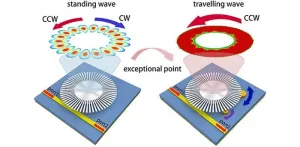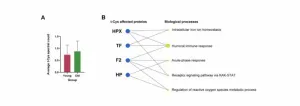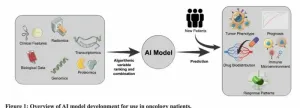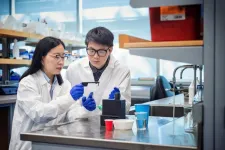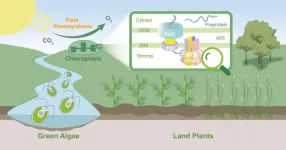(Press-News.org) DNA methylation is a process in which a methyl group is attached to the cytosine base of the DNA molecule, and a major way that DNA is epigenetically marked. Epigenetic modifications can act as on-off switches to regulate gene expression and help generate diverse cell types without changing the underlying DNA sequence. It is how the body ensures that brain-related genes don’t get turned on in heart cells, for example.
For this reason, maintenance of the DNA methylation pattern is important to ensure the correct and consistent function of each cell type. But this is no easy feat: the DNA methylation pattern can change over time, and this is linked to a variety of diseases. One is a rare genetic condition called immunodeficiency, centromeric instability and facial anomalies (ICF) syndrome, whose symptoms include recurrent respiratory infections, facial anomalies, and slowed growth and cognition.
While it has been known that mutations in the CDCA7 gene cause ICF syndrome, little was known about the gene’s molecular function. Now Rockefeller University’s Funabiki lab, in close collaboration with researchers at the University of Tokyo and Yokohama City University, has identified a unique functional feature of CDCA7 that ensures the accurate inheritance of DNA methylation.
The researchers discovered that CDCA7 senses hemimethylation in eukaryotes—an important find, because hemimethylation sensing has long been thought to be solely carried out by a protein called UHRF1. They published their results in Science Advances.
“It’s quite an incredible finding,” says co-first author Isabel Wassing, a postdoc in the Laboratory of Chromosome and Cell Biology, headed by Hiro Funabiki. “Learning that CDCA7 also acts as a sensor explains why its mutation leads to diseases like ICF syndrome and fills in a major gap in the field of epigenetics. But it also introduced new questions. Why, for example, does the cell need two different hemimethylation sensors?”
A transitional state
Massive cycles of cell division, in which a parental cell is split into two identical daughter cells, give rise to the trillions of cells that make up the human body. Careful replication and segregation of the DNA molecule, packaged into chromosomes, allows for the accurate inheritance of genetic instructions to each new daughter cell.
DNA replication is a tricky process. At the heart of a cell nucleus is chromatin, a complex of macromolecules composed of double-stranded DNA and histone proteins, which DNA wraps around like a string on a yo-yo to form nucleosomes. During replication, the double-stranded DNA strand unwinds from around the histone and splits into two single strands; DNA polymerases then stitch complementary nucleotides across each strand, resulting in two copies of the double-stranded DNA molecule.
However, the methyl groups are not automatically copied onto the newly synthesized DNA strand, rendering it temporarily hemimethylated: the old parental DNA strand is methylated, while the newly incorporated nucleotides in the daughter DNA strand are not, which signals that DNA methylation maintenance is required. Indeed, the detection of hemimethylation by UHRF1 is the crucial first step; the protein then recruits and activates the DNA methyltransferase DNMT1, which deposits the methyl mark on the newly synthesized DNA strand.
The stakes are high, as the cell’s ability to sense the presence of hemimethylation has a strict deadline: If the hemimethylated state of DNA is not recognized before the next round of replication, the epigenetic methylation mark is permanently lost.
The chromatin problem
Scientists know that the access of many enzymes and DNA-binding proteins is restricted by chromatin, including those that are necessary to introduce methylation to the DNA. Earlier research by the Funabiki lab showed that CDCA7 forms a complex with the protein encoded by the HELLS gene, whose mutations also cause ICF syndrome. HELLS is a so-called nucleosome remodeler, which can temporarily unwrap the DNA molecule from the nucleosome.
“We envisioned that the CDCA7-HELLS complex is important to help the cell overcome the barrier of compacted heterochromatin and make the DNA molecule accessible to the deposition of methylation,” explains Funabiki. “But there are many different nucleosome remodelers that are able to expose the DNA molecule in this way. It remained a mystery to us why CDCA7-HELLS is the only nucleosome remodeling complex directly associated with DNA methylation maintenance. Now that we’ve shown that CDCA7 specifically recruits HELLS to hemimethylated DNA, this finally provides an explanation.”
In this new model, CDCA7 recognizes the hemimethylated DNA in chromatin and recruits HELLS to the site, which, as a nucleosome remodeler, slides the nucleosome out of the way, revealing the hemimethylation site to UHRF1.
The handover of hemimethylation sensing indicates that CDCA7 is better at detecting hemimethylation within the dense heterochromatin than UHRF1 is. It also explains the cell’s need for two different sensors. “For these sensors to detect hemimethylation, they must directly and selectively bind the hemimethylated DNA substrate,” Wassing says. “CDCA7 seems uniquely able to do that while the DNA is wrapped around the nucleosome. Without it, UHRF1 would be blind to the hemimethylation signal within the nucleosome particles.”
This new understanding may help illuminate the underlying mechanisms of diseases born from dysfunctional methylation. In the future they’ll seek out functions for hemimethylation sensors beyond DNA methylation maintenance.
“Since some chromosomal regions are known to preserve hemimethylation status, their recognition by CDCA7 may have much broader roles in gene regulation and chromosome organization,” Funabiki says. “It’s an exciting possibility.”
END
Second genetic sensor for DNA methylation discovered
2024-08-27
ELSE PRESS RELEASES FROM THIS DATE:
New sensor technology enhances detection of tiny particles
2024-08-27
In recent years, advances in photonics and materials science have led to remarkable developments in sensor technology, pushing the boundaries of what can be detected and measured. Among these innovations, non-Hermitian physics has emerged as a crucial area of research, offering new ways to manipulate light and enhance sensor sensitivity. A recent study published in Advanced Photonics Nexus reports a breakthrough in this field, presenting a new type of sensor that leverages exceptional points (EPs) to achieve unprecedented levels of sensitivity.
This study introduces a highly sensitive and reconfigurable sensor based on a single ...
New technology ‘lights up’ bacteria in wounds for better infection prevention
2024-08-27
LOS ANGELES — Over 6.5 million Americans experience chronic wounds — wounds that do not heal after a few months. Almost all such wounds contain bacteria, which, if not detected and removed, can lead to severe infection and resulting complications, including amputation if a limb is involved.
This is especially true for patients with diabetic foot ulcers (open sores), which affects one-third of people with diabetes. Approximately 20% of those who develop a diabetic foot ulcer will require a lower-extremity amputation, according ...
UCLA receives $120 million from Alya and Gary Michelson for new California Institute for Immunology and Immunotherapy
2024-08-27
UCLA has received a $120 million commitment from surgeon, inventor and philanthropist Dr. Gary Michelson and his wife, Alya, to kick-start the California Institute for Immunology and Immunotherapy, an innovative public-private partnership aimed at spurring breakthrough discoveries that prevent and cure diseases and catalyze economic growth and innovation in Los Angeles.
Michelson, a spine surgeon and prolific inventor who holds nearly 1,000 individual patents, is co-founder and chair of the board of the institute, which will be housed at UCLA’s state-of-the-art research park.
The gift, distributed via ...
Dunick receives funding for Center For Economic Education
2024-08-27
Dunick Receives Funding For Center For Economic Education
Jason Dunick, Associate Chair and Term Associate Professor, Economics, College of Humanities and Social Sciences (CHSS), received $108,692 from Virginia Council on Economic Education for: “Center for Economic Education.”
Dunick will use this funding to support the continuation of the services of the Center for Economic Education. The Center supports K-12 teachers who are teaching economics and personal finance in Virginia.
This grant represents the renewal of a long-standing relationship with the ...
National Institutes of Health awards $2.4 million grant to cross-disciplinary team of researchers to study psychedelics for methamphetamine addiction
2024-08-27
FOR IMMEDIATE RELEASE
Media Contacts:
Colleen McDonald
Sr. Consultant, Earned Media
Kara Reed
Director of Development
Lisa Babin
Executive Director of Communications
Medical College of Wisconsin
University of California San Diego
LSU Health Shreveport
414.801.3146 | cmcdonald@mcw.edu
217.390.6629 | k3hendrickson@ucsd.edu
318.675.8769 | lisa.babin@lsuhs.edu
Milwaukee, Wis., August 27, 2024 – John McCorvy, PhD, Assistant Professor in the Department ...
Trioxidized cysteine and aging: Beyond proteinopathic paradigms
2024-08-27
“The results indicated a significant increase in cumulative t-Cys levels and the total number of t-Cys residues in aging and aged mice proteomes compared to young groups.”
BUFFALO, NY- August 27, 2024 – A new research perspective was published in Aging (listed by MEDLINE/PubMed as "Aging (Albany NY)" and "Aging-US" by Web of Science), Volume 16, Issue 15 on July 25, 2024, entitled, “Trioxidized cysteine and aging: a molecular binomial that extends far beyond classical proteinopathic paradigms.”
Oxidative stress (OS) - characterized by an imbalance between oxidants and antioxidants - leads to the formation ...
Artificial intelligence: Revolutionizing precision oncology
2024-08-27
“Properly leveraged AI-based techniques could herald a new era of precision medicine guided by non-invasive, imaging-based disease evaluation."
BUFFALO, NY- August 27, 2024 – A new editorial was published in Oncotarget's Volume 15 on August 26, 2024, entitled, “Artificial intelligence: A transformative tool in precision oncology.”
Artificial intelligence (AI) is revolutionizing society and healthcare, opening new possibilities for precision medicine. In oncology, immunotherapy (IO) has similarly transformed cancer treatment with novel ...
How much microplastic are you drinking? New UBC tool can tell you in minutes
2024-08-27
Micro- and nanoplastics are in our food, water and the air we breathe. They are showing up in our bodies, from testicles to brain matter.
Now, University of British Columbia researchers have developed a low-cost, portable tool to accurately measure plastic released from everyday sources like disposable cups and water bottles.
The device, paired with an app, uses fluorescent labeling to detect plastic particles ranging from 50 nanometres to 10 microns in size – too small to be detected by the naked eye – and delivers results in minutes.
The method and findings are detailed in ACS Sensors.
“The breakdown of larger plastic pieces into microplastics ...
Race and ethnicity and diagnostic testing for common conditions in the acute care setting
2024-08-27
About The Study: White patients discharged from the emergency department with a nonspecific diagnosis of interest were significantly more likely than Black patients to receive related diagnostic testing in this study. The extent to which this represents diagnostic test overuse in white patients vs undertesting and missed diagnoses in Black patients deserves further study.
Corresponding Author: To contact the corresponding author, Michael I. Ellenbogen, M.D., email mellenb6@jhmi.edu.
To access the embargoed study: Visit our For The Media website at this link https://media.jamanetwork.com/
(doi:10.1001/jamanetworkopen.2024.30306)
Editor’s ...
Groundbreaking studies provide key insights into chloroplasts protein import motor
2024-08-27
Two groundbreaking studies published in the journal Cell shed light on the assembly, function and evolutionary diversity of the chloroplast protein import system.
Chloroplasts are fundamental organelles in plant cells that act as the primary site of photosynthesis to sustain life on Earth. Although chloroplasts have their own genome, most of their proteins are encoded in the nucleus and synthesized as preproteins in the cytosol. These preproteins are subsequently transported across the outer and inner envelope membranes of the chloroplasts. The translocon machineries, known as the TOC (translocon at the outer chloroplast membrane) and TIC (translocon at ...
